FUNERALS & BURIALS:
Symbols, Traditions & Meanings of Terminology
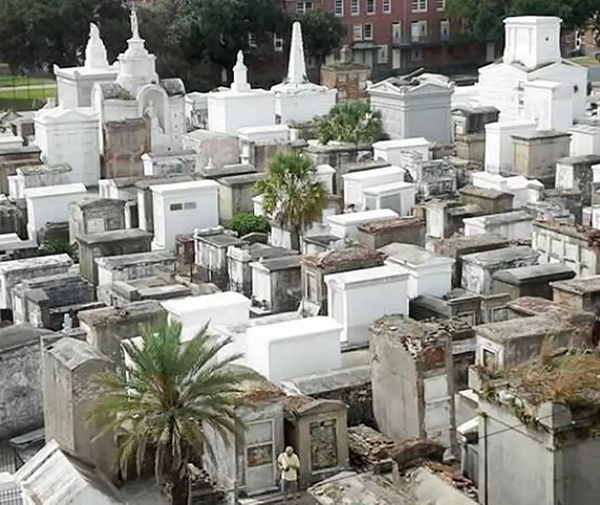
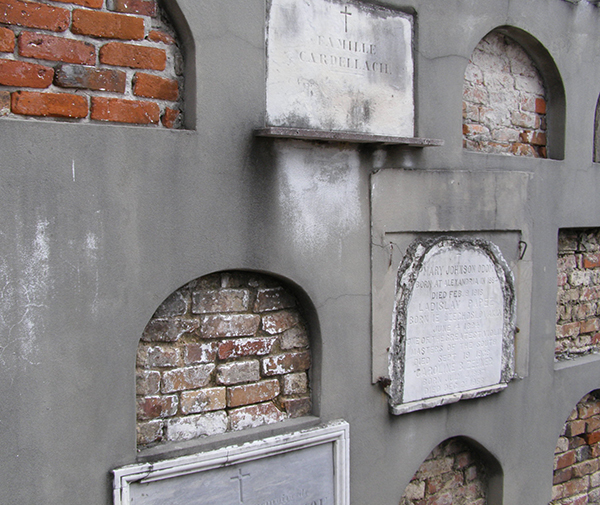
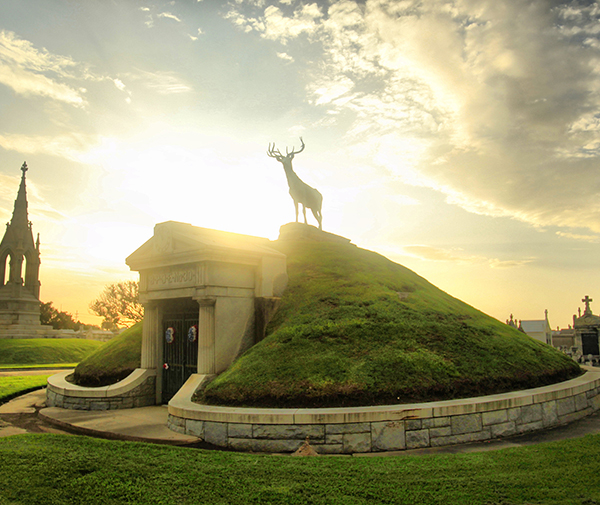
The Moniker "Cities of the Dead"
New Orleans cemeteries have been dubbed "Cities of the Dead" since the city's earliest days. Why? The rows of tombs resemble streets, the tomb-lined walkways like narrow thoroughfares through concrete slab houses where the dead rest. As soon as you enter a cemetery, you are literally surrounded by the dead as even the walls are tombs filled with remains. Keep in mind, New Orleans' burial plots are also largely associated with vampire lore as they appear to be accommodating to those who need some rest in the afterlife.
Wall & Oven Vaults
Each original New Orleans cemetery is surrounded by a perimeter of wall and oven vaults. These walls of tombs have been described as “cells of a honey comb”. A year and a day after the funeral, remains are pushed towards the rear to make room for the next coffin. Therefore, in the recesses of the wall vaults there lie successive generations of mingled remains. Burials in wall vaults were to be more economical, while wealthier families could afford the larger, ornate tombs with crypts.
Tumulus (burial mounds)
A tumulus is a mound of earth and stones raised over a grave or graves. In Metairie Cemetery, atop the tumulus stands a 38 foot column, upon which is a statue of Lieutenant General Thomas “Stonewall” Jackson. In Greenwood Cemetery, the grassy tumulus represents The Elks Lodge. This type of burial once graced many more New Orleans cemetery landscapes than it does today, and it origins date back to pre-Roman and Roman cultures.
In New Orleans, you will discover cemeteries dating back as early as 1789. You will find massive military tombs, memorials paying tribute to unidentified victims of Hurricane Katrina, and a triple-x marked tomb believed to house Voodoo Queen Marie Laveau. Above all, you will uncover the relationship between the city and the spiritual world that is both haunting and historic.
New Orleans’ cemeteries are beautiful and grandiose, serving as one of the city’s most alluring visitor attractions. Its above-ground tombs are a unique development to compensate for the city's precarious position with tropical climate and topography below sea level.
While visitors and locals hunt and haunt through these Cities of the Dead, it is helpful to have some knowledge about the city's funerary symbols, death traditions, and cemetery terminology.
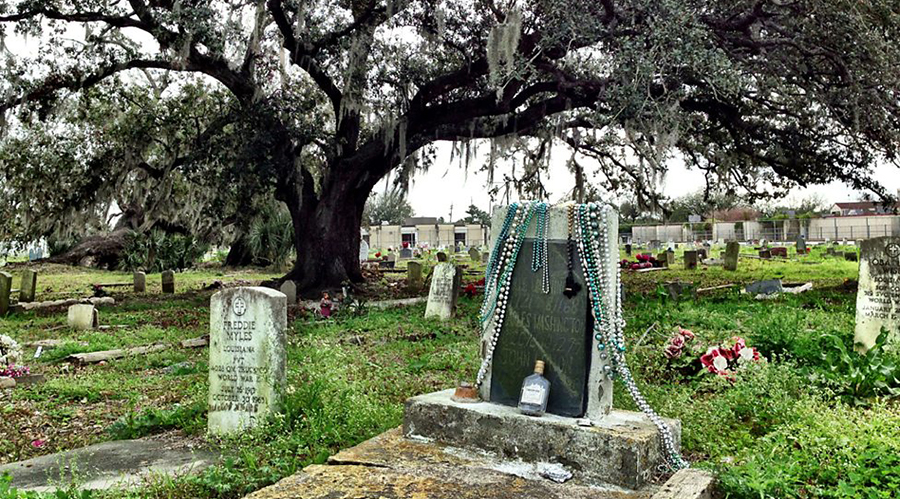

In-ground Burials
This style of burial is considered to be the first type used in the cemetery, dating back to the late 1700s or early 1800s. Although New Orleans and its cemeteries are famous for the unique Mediterranean-style above-ground tombs, in-ground burials are commonly used as well. Holt Cemetery is a good example of mainly in-ground burials.
Above-ground Burials
Since the city of New Orleans was largely built on a swamp several feet below sea level, interring a body six feet under is not a viable option. Above-ground tombs were originally constructed to prevent the recently deceased from floating up from the soggy ground.
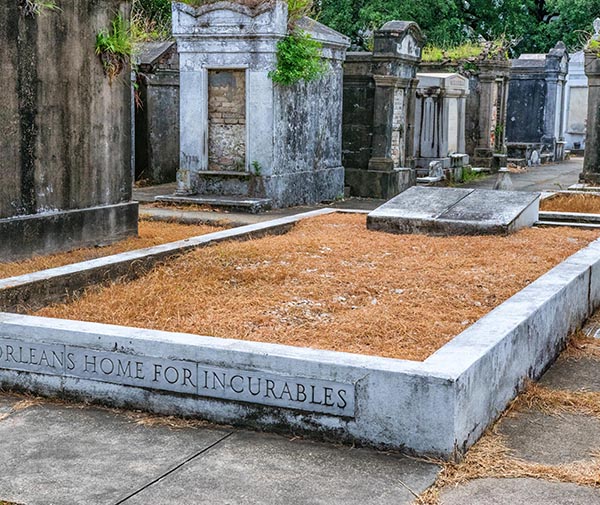
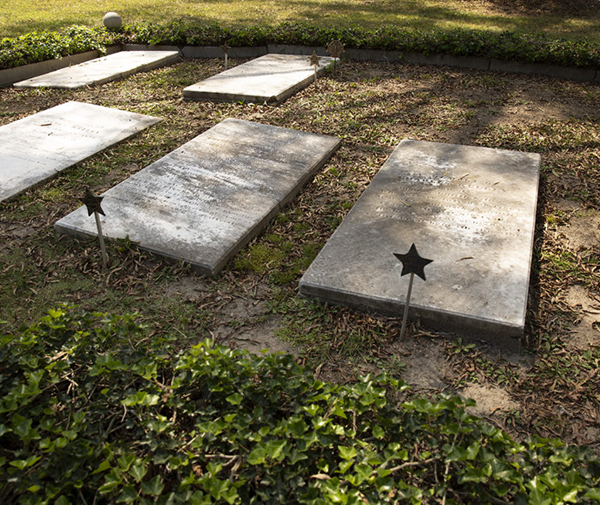

Coping Tombs
These types of burial sites are made of a set of plaster-sealed stone, marble, or granite walls that seal off the coffin from pending water levels. Generally, coping graves remain uncovered, with the exception of gravel, and can be built to around 3 feet above the ground.
Ledger Stone
Watch where you step. These large and flat stones are placed on top of the grave plot to seal in the coffin. Some of the Ledger Stones in the New Orleans cemeteries are engraved—with family history, personal touches, and well wishes.
Society Tombs
A society tomb is a multi layered tomb wall that contains several burial vaults. Society tombs were New Orleans’ version of community mausoleums. Professional or benevolent societies were common in the early history of New Orleans and served to administer to the burial needs of the individuals who belonged to them.
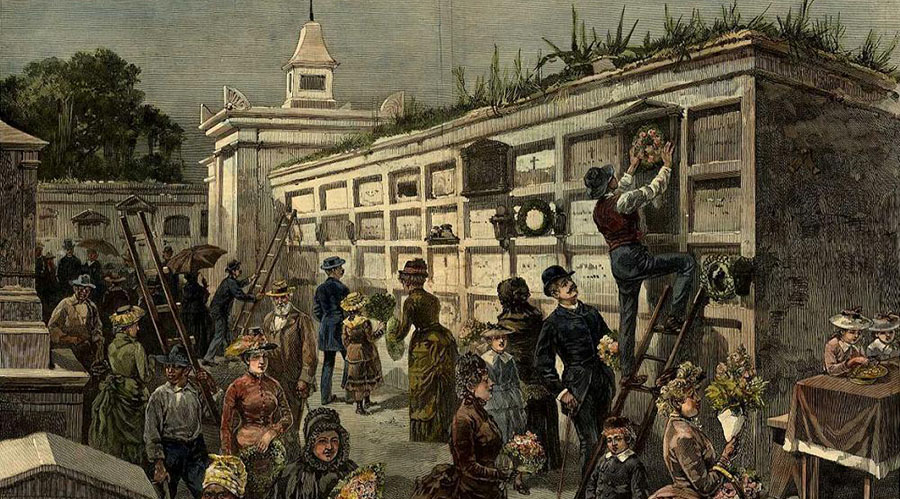
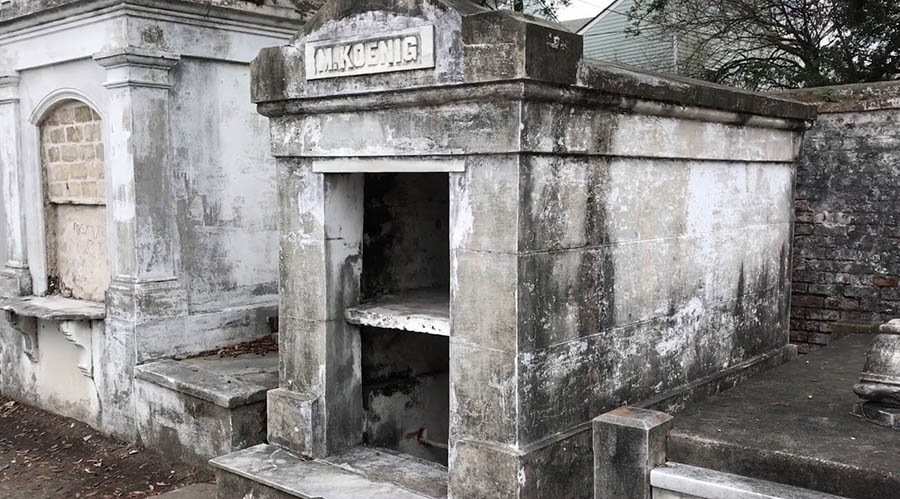
All Saints' Day
a.k.a. All Hallows' Day, Hallowmas & Feast of All Saints
In New Orleans, the most illuminating spirits are not found in a graveyard on October's last eve, but in the hauntingly beautiful traiditions that play out the day after. All Saints Day is a festive holiday to honor the dead annually on November 1st by decorating the tombs in the cemetery with flowers, vases, candles and draperies, followed by church services. It is a day to visit the dead by traveling to the place of their interment as the veil between worlds is at its thinnest.
"A Year and a Day"
According to local lore, after a year of entombment, human remains turn to ash, so the phrase "a Year and a Day" refers to the amount of time that must pass before a body interred in one of New Orleans’ above-ground tombs decomposes, leaving only bones behind. At that point, the tomb—which acts like an oven in the subtropical heat, subjecting the body to a process resembling slow cremation—can be opened. This custom is also common for the Judeo-Christian custom of mourning for a year and a day.


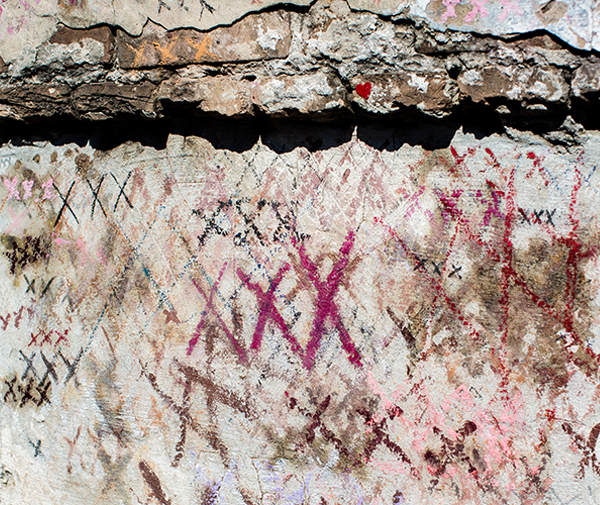
Caveau
Traditionally, a body was inserted in a wooden coffin into the tomb, where it was left until the next burial, at least a year and one day from the previous to allow the body to decompose. When the tomb was reopened, whatever was left inside after sitting in 300-degree heat for a year--typically bones and the coffin padding and handles--was swept into the pit at the bottom of the tomb, called a caveau (French for cellar). Therefore, a caveau lies beneath the coffin of a vault and holds the ashes of an entombed body after a year and a day.
Take Only Pictures; Leave Only Footprints.
Leaving coins, candles, flowers or fruit is a common practice as a gift or offering. Along with these mementos is the act of marking tombs, usually with three x’s. Some people believe an old Voodoo tradition of marking three X's on a tomb and saying some magic words awakens the spirit of the person interred to grant your wish. Unless your wish is to pay a fine for the destruction of property, never make a mark on a tomb. It is an act of vandalism and is extremely disrespectful and 100% illegal.
X X X
The three Xs are common on voodoo tombs, and, according to the oldest traditions, must be made with a cemetery brick. The tradition, like the Voodoo religion itself, is a combination of Catholicism and African (Yoruban) spiritual practices. The X, or any crossed lines, represent the intersection between the physical and spiritual worlds, as we are always trying to communicate with the spirits, ancestors, and saints on “the other side.” Three of them represent the Holy trinity in the Catholic faith – Father, Son, and Holy Spirit- which, to Catholics, is the upper echelon of that unseen world.

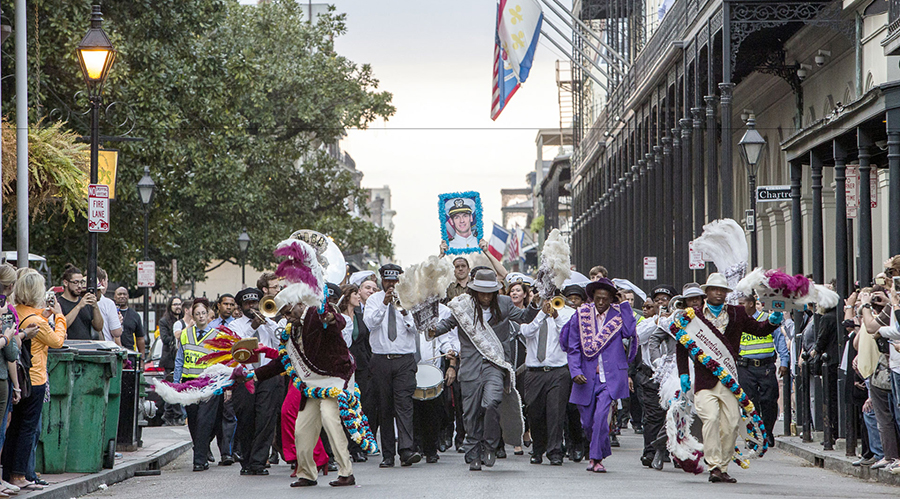
Traditional Second Line Parade
There are two parts to a second line. The first line is made up of the grand marshal or parade leader, the band, and whoever is being honored. The strutting revelers who fall in behind are referred to as the second line. The leaders of the parade carry decorated umbrellas, while the other participants shake handkerchiefs while they dance. A brass band plays some beats that gets everyone dancing and moving. Second line parade are common for wedding processions, festival kick-offs, Mardi Gras celebrations, and funerals.
Jazz Funeral Second Line
Jazz funerals are a big part of New Orleans culture, and with jazz funerals, comes second lines. During a funeral second line, the hearse is moved from the funeral to the burial service, joined by guests. A jazz band accompanies the procession to celebrate the life of the deceased. In a traditional New Orleans jazz funeral, the family and the hearse are part of the first line, and the mourners follow as the second line. The band begins with a slow, mournful tune but then picks up the beat to a celebratory rhythm for all to dance.
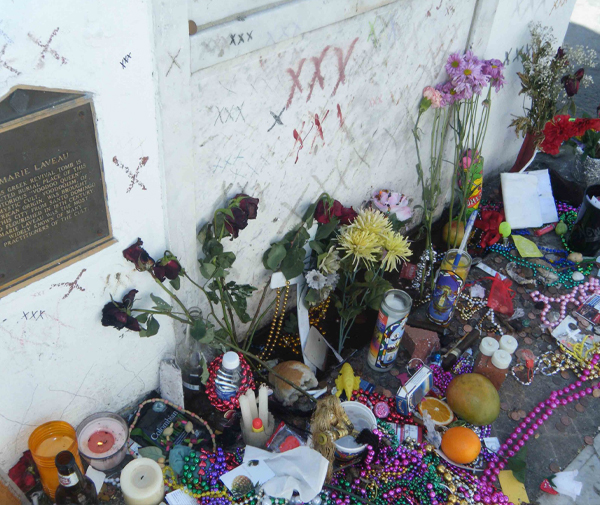
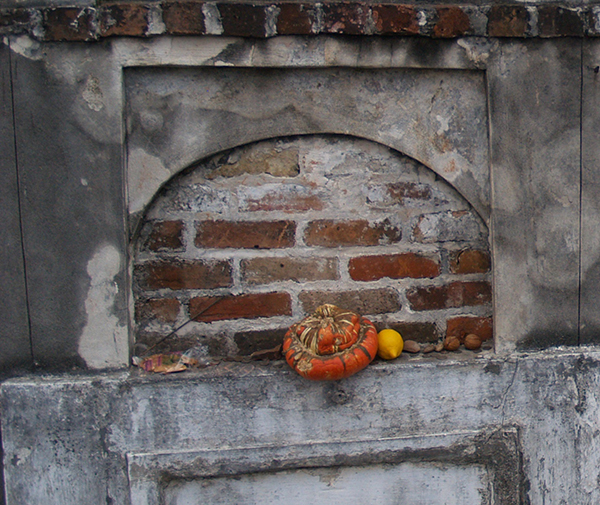
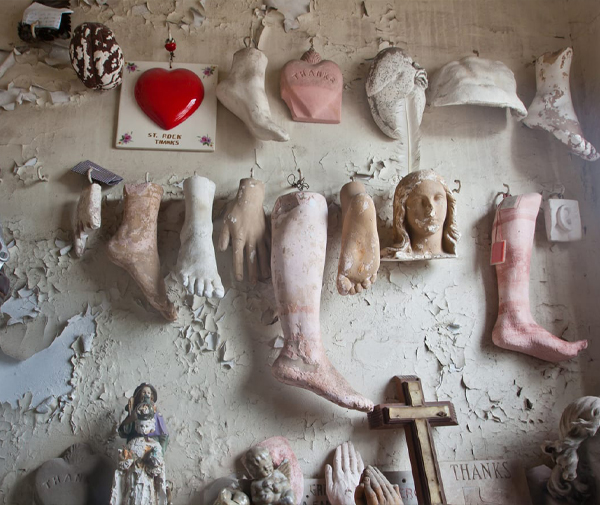
Voodoo Offerings
People came from all over to leave offerings of various kinds as a part of a Voodoo ritual or as a sign of gratitude to the spirits for granting a wish. A wide assortment of these offerings have been found around tombs, such as candles, coins, small statues, beads, empty beer cans, flowers, notes, and plenty of other random items. Leaving offerings like flowers, pennies, or other mementos is appropriate; marking graves is definitely not.
The Wishing Vault
The so-called Wishing Vault is believed by some to be the “secret” resting place of Marie Laveau, the Voodoo Queen of New Orleans who died in 1881. Popular believe is that she is in her family tomb in St. Louis #1, where most tour guides will lead. The Archdiocese of New Orleans has no record of who is in this vault, only a notation that “this vault is full.” The Wishing Vault is located beside Jordan Noble in Saint Louis Cemetery No. 2.
Shrine of Life: St. Roch Chapel
Hanging inside the chapel at St. Roch Cemetery in the Bywater of New Orleans, the sacrificial limbs of New Orleanians are left behind as offerings left by those in need of healing. The chapel honors St. Roch, who is associated with good health and healing, so along with prayers, churchgoers have left rows of prosthetic legs, plaster feet, false teeth, children's polio braces, crutches, rosaries and figurines.
SYMBOLISM
It is customary for the bereaved to select the style of tomb that will hold the remains of their loved one. Many families also elect to embellish the tomb with a symbol as an expression of love and remembrance. As they adorn the tomb or inscribe symbols on the enclosure tablet, funerary symbolism meanings reference everything from the occupation of the deceased to their religious beliefs. Combining one or two or more of the symbols express a family's feelings for their family members buried in the tomb.
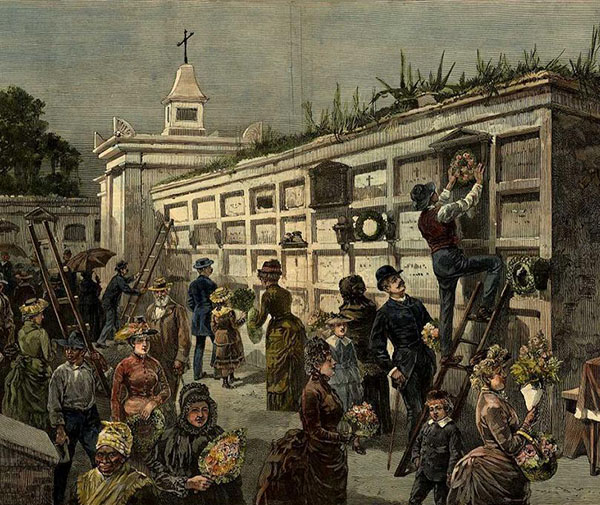
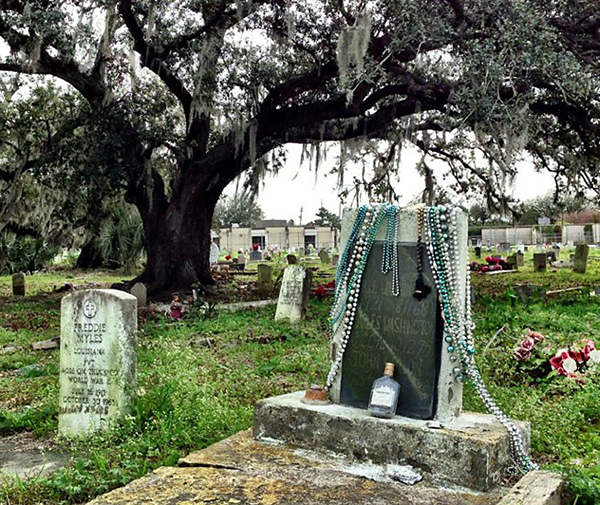
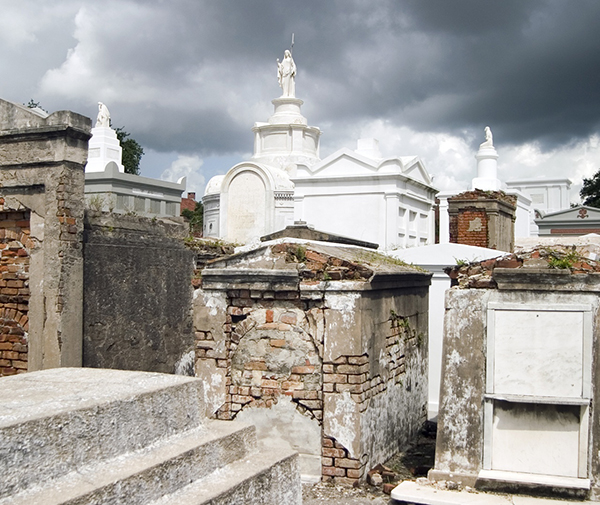
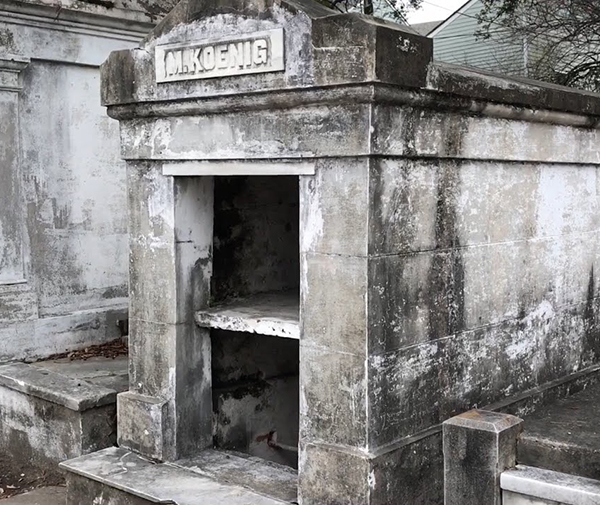
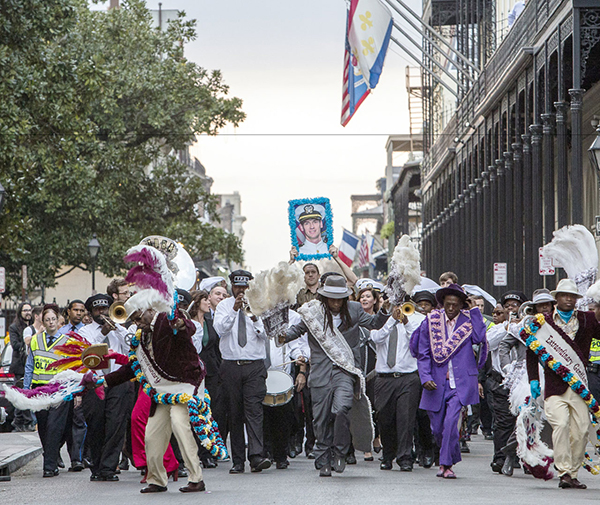
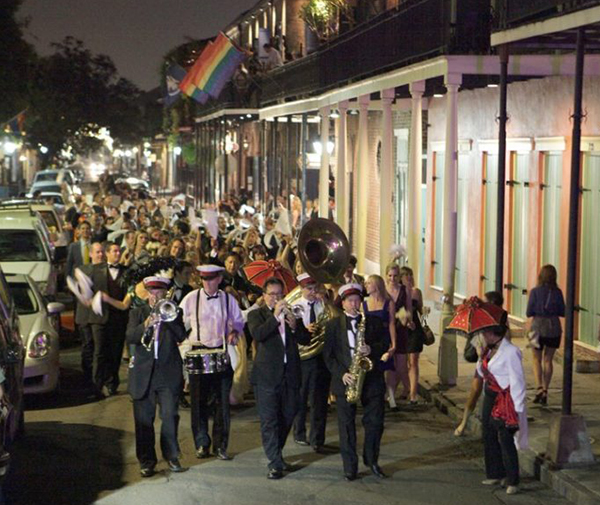

Anchor
Salvation and hope. Also used to commemorate a mariner.
Angel
A symbol of a guardian and spiritual invisible forces. Angels are a symbol of rebirth and resurrection as the power between the heavens and the earth.
Arrow
Mortality. The arrow piercing a heart represents a bond, be it familial or through marriage.



Birds
Symbolic of the spirit, illustrating that the soul flies away after death.
Books
A Minister or a teacher. Open holy books are representative of a variety of religions and beliefs.
Butterfly
Sometimes symbolic of loss of life at a young age.



Candle
The lighted candle is a symbol of individual light. Therefore, a candle snuffed out represents loss of life; mortality.
Clasped Hands
Farewell to an earthly existence. This familiar emblem represents solidarity in the face of danger, eternal unity, or affection for the deceased. Also symbolizes unity (perhaps with God, or with the spouse who had gone before). Used also as a symbol for members of the Masonic movement and Independent Order of Oddfellows.
Coffin
Transformation. In a more literal sense, the coffin symbolizes loss of life.



Column
Associated with commemoration, it is most often used as a war memorial. A broken column represents a life cut short, usually the loss of the head of a family.
Covered Column
A cloth draped over a column (or an urn) represents the pall – the covering for a coffin in a funeral procession. This is where the expressions "pallbearers" and "cast a pall over…" come from.
Cornucopia
A horn-shaped device, overflowing with fruit represents a rich and fruitful life. Also a symbol of the harvest, which in turn indicates the end of a natural cycle. A symbol of the Order.



Cross
Represents faith and resurrection. A heavily religious symbol, the cross if by far the most widely used of all funerary symbology.
There are different versions of the Christian cross represented on cemetery headstones:
Latin Cross
One of the oldest and simplest symbols of Christianity and the most commonly-used. It has also been called 'God's mark.'
Calvary Cross
A Latin cross standing on three steps or blocks, it signifies faith, hope and charity (or love).
Botonee Cross
So named because of its modified trefoil (three-lobed) ends, represents the trinity.
Celtic Cross
The circle around the crosspiece symbolizes eternity. Its origin can be traced to the Celtic cultures of the British Isles.
Eastern Cross
Used in Orthodox (Russian/ Greek) Christian Religions, this cross' upper horizontal shoulder represents the inscription over the head of Jesus on the actual cross of the crucifiction. The lower slanting shoulder represents the footrest of the crucified Jesus.
Flueree Cross/Gothic Cross
This flowered cross symbolizes the adult Christian by its more opened flared out ends.
Ionic Cross
Similar to the Celtic Cross, with outward-flaring ends. The ionic cross signifies everlasting salvation, love and glory. The circle around the crosspiece symbolizes eternity.

Crown
Symbol of spiritual enlightenment, perfection in death, a classic symbol of immortality.
Daisy
A flower symbolic of innocence, representing loss of life at a young age.
Dog
Implies the deceased was a good master, worthy of love.



Dove
Widely known as a symbol of peace.
Eye of God
Symbolizes the omnipresence of God. The eye of God enclosed in a triangle represents the Trinity.
Fleur de Lis
Spiritually, it represents an Iris, a beautiful purple bloom that symbolizes the holy Trinity. Fleur is French for flower, de meaning of and li meaning three. It has become the symbol of New Orleans.



Flame
A flame in the forms of a light, lamp or torch represents immortality of the spirit.
Flower
Flowers all have their own unique associations, but overall represent human life and beauty. A broken flower symbolizes a life cut short, sometimes at a young age.
Fruit
Symbolic of earthly desires, the fruit of life and eternal plenty.



Hand
A hand with the index finger pointing upwards symbolizes the hope of of an eternity in heaven. Hands holding a chain with a broken link symbolizes the death of a family member. The hand of God plucking a link of the chain represents God bringing a soul unto himself. A hand holding a heart is a symbol of the Lodge of Oddfellows. A Handshake is a welcome to the heavenly world.
Heart
The symbol of love as the center of happiness, representing love for the deceased. When two hearts are joined, it is usually indicative of a marital bond. The Flaming Heart signifies extreme ardor. The heart encircled with thorns symbolizes the suffering of Christ. A heart pierced by a sword symbolizes the Virgin Mary.
Hourglass
A vessel for measuring time, therefore representing time has run out. An hourglass is an attribute of death and Father Time, symbolizing the passage of time and the shortness of life. The Hourglass with Wings is the symbol of Chronos, the Greek Titan of time. Simply translated, it means “time flies,” or death comes too soon.



IHS
The first three letters of Jesus' name in the Greek alphabet. It can also be interpreted to stand for 'In hoc signo' which is Latin for 'by this sign we conquer' – referring to the cross of Christianity.
Ivy
Representative of immortality and friendship.
Lamb
Purity or innocence. Most often represents loss of life at a young age.



Laurel Leaves
An evergreen plant. The laurel leaves represent the evergreen memory those left behind may have of the deceased.
Leaves
Oak leavens on tomb can stand for power, authority, or victory. Often seen on Military tombs.
Lily
All lilies symbolize innocence and purity. Calla lilies specifically are a symbol associated with marriage.



Lion
Represents earth. As such, this classic symbol of courage stands guard of the tomb on this earthly plane.
Obelisk
19th century Egyptian revival decoration universally associated with commemoration.
Palm
The palm branch symbolizes victory, rejoicing and sometimes eternal peace.



Pansy
This flower is associated with thought and therefore represents remembrance.
Poppy
A symbol of eternal rest.
Praying Hands
A Christian symbol representing the final prayer; asking God for eternal life.




Rod & Staff
Widely associated with support or comfort for the bereaved.
Rooster
The rooster's place in life is to awaken, therefore in funerary art a rooster represents awakening; resurrection.
Rosemary
A symbol of remembrance.



Sarcophagus
A stone container for a body or “coffin.” In its classical form, this tomb style resembles an actual coffin covered with a heavy stone lid, resting either on a podium or a low foundation.
Scythe
An instrument of the harvest and therefore known as the classic symbol of death.
Seashell
Represents a journey.



Square & Compass
A sign of the Freemasons. Both the square and compasses are architect's tools and are used in Masonic ritual as emblems to teach symbolic lessons.
Star
A sign that the light of the spirit is eternal and will always illuminate the darkness of light.
Stars & Stripes
Often commemorates a military officer, symbolizing eternal vigilance and liberty.



Sun
A symbol of light and warmth, of life, and eternal life.
Swords
Crossed swords commemorate a Military person of high rank.
Tombstone with R.I.P.
The abbreviation R.I.P. stands for the Latin "Reqiescat in Pace" meaning to Rest in Peace.



Torch
Originally the torch was a Greek symbol of life and truth. The upright torch stands for everlasting life. The inverted torch represents death. An upside-down torch is a symbol of the end of life, because when a burning torch is turned upside-down, the fire is extinguished.
Trees
The Tree Trunk stands for the brevity of life. Tree Sprouting stands for life everlasting. Weeping Willow tree is an emblem of perpetual mourning.
Trumpeters
Taken from classical paintings, trumpeters are the harbingers of the resurrection.



Urn
As a receptacle for the ashes of the deceased, the urn is a symbol of mortality, of mourning. Ancient Egyptians used to store vital organs in an urn, believing that life would be restored through them. This has given the urn to also mean everlasting life.
Vermiculation
A stylized representation of worm tracks, usually on the bottom plinths of monuments. Vermiculation is a reference to earthly decay.
Wreath
A symbol of victory. As an unbroken circle signifying infinity, it also represents eternal life.
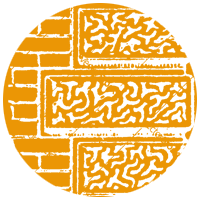

The Legend of the "Devil's Chair"
19th century graveyards included "mourning chairs" for the comfort of visitors. Superstitions have developed in association with the act of sitting in these empty chairs. Urban legends vary but always suggest the person brave enough to sit in the chair may be punished for impudence of rewarded for courage
The symbolism of the empty chair is not limited to cemeteries. It is how the likelihood of Tiny Tim’s death is revealed to Scrooge in A Christmas Carol. Those who have ever watched Les Misérables know the song “Empty Chairs at Empty Tables,” sung by one of the few survivors of a failed revolution to his fallen comrades. An unoccupied chair is a silent reminder of those who are not with us.
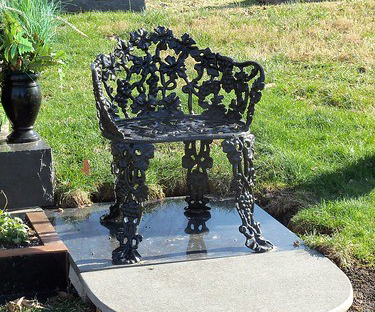

Rose
Roses have many different meanings, depending on its appearance. The single rose is a symbol of perfection, of completion, and brevity of earthly existence. The eight petalled rose is known to represent regeneration, awakening. A fully bloomed rose is a symbol of death in the prime of life. A red rose symbolizes martyrdom, a while rose symbolizes purity, a blue rose symbolizes the impossible.

Three-link Chain
The Three-link Chain ("the Chain With Three Links" or "Triple Links") signifies Friendship, Love and Truth which is the dogma of a non-political and non-sectarian international fraternal order known as the The Independent Order of Odd Fellows. This chain is a widely encountered symbol of The Odd Fellows (IOOF), and when seen on a cemetery headstone, it indicates that the deceased belonged to this fraternal organization.
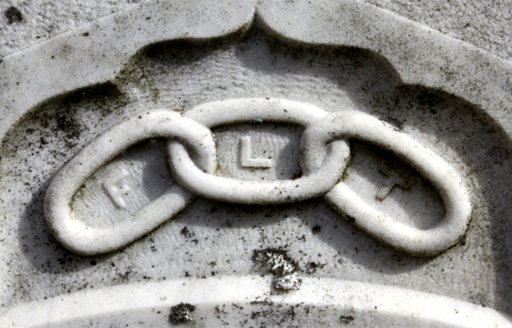

SPOTLIGHT ON SECOND LINES:

SITE CURRENTLY UNDER CONSTRUCTION.
• • •
Please pardon our pixel dust!
SITE CURRENTLY UNDER CONSTRUCTION.
